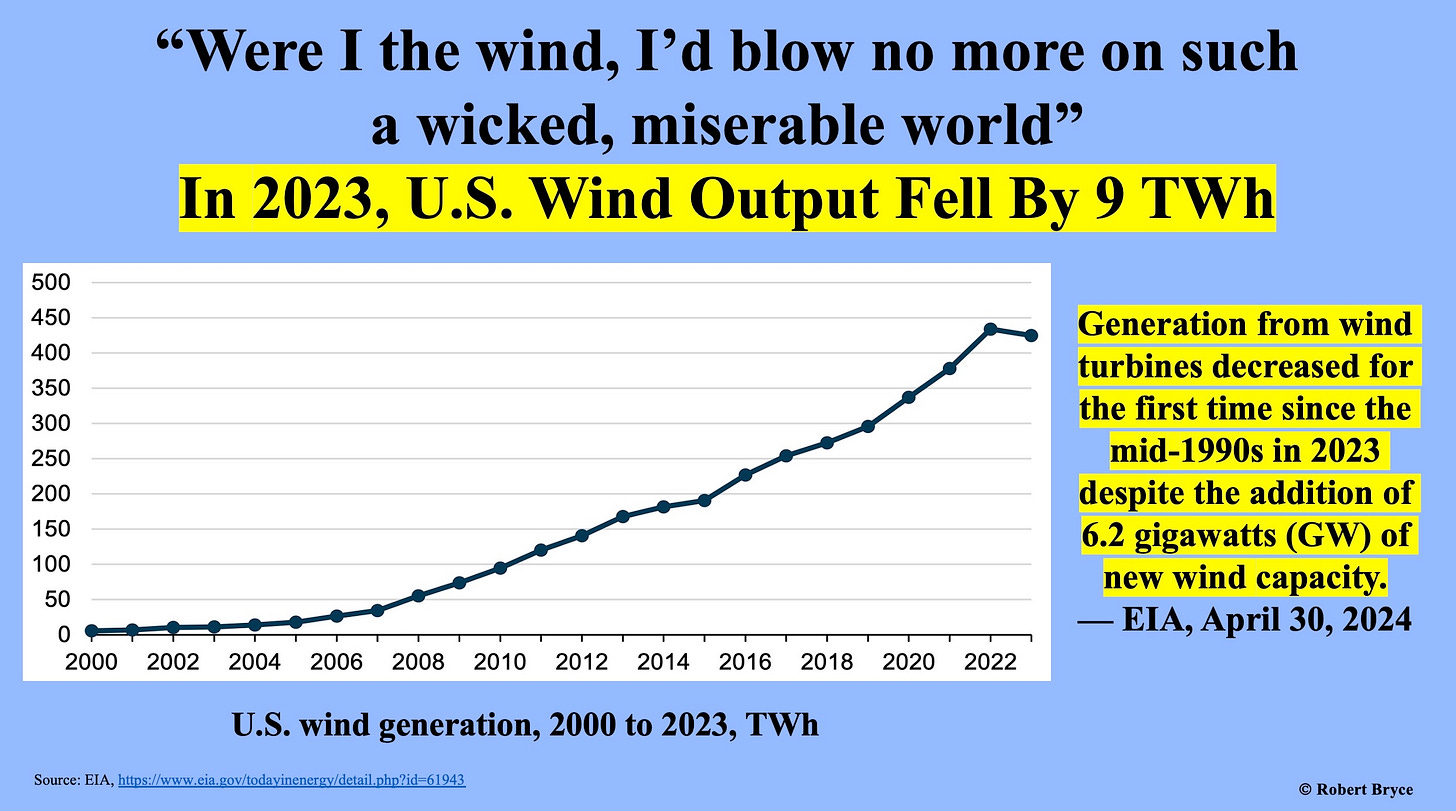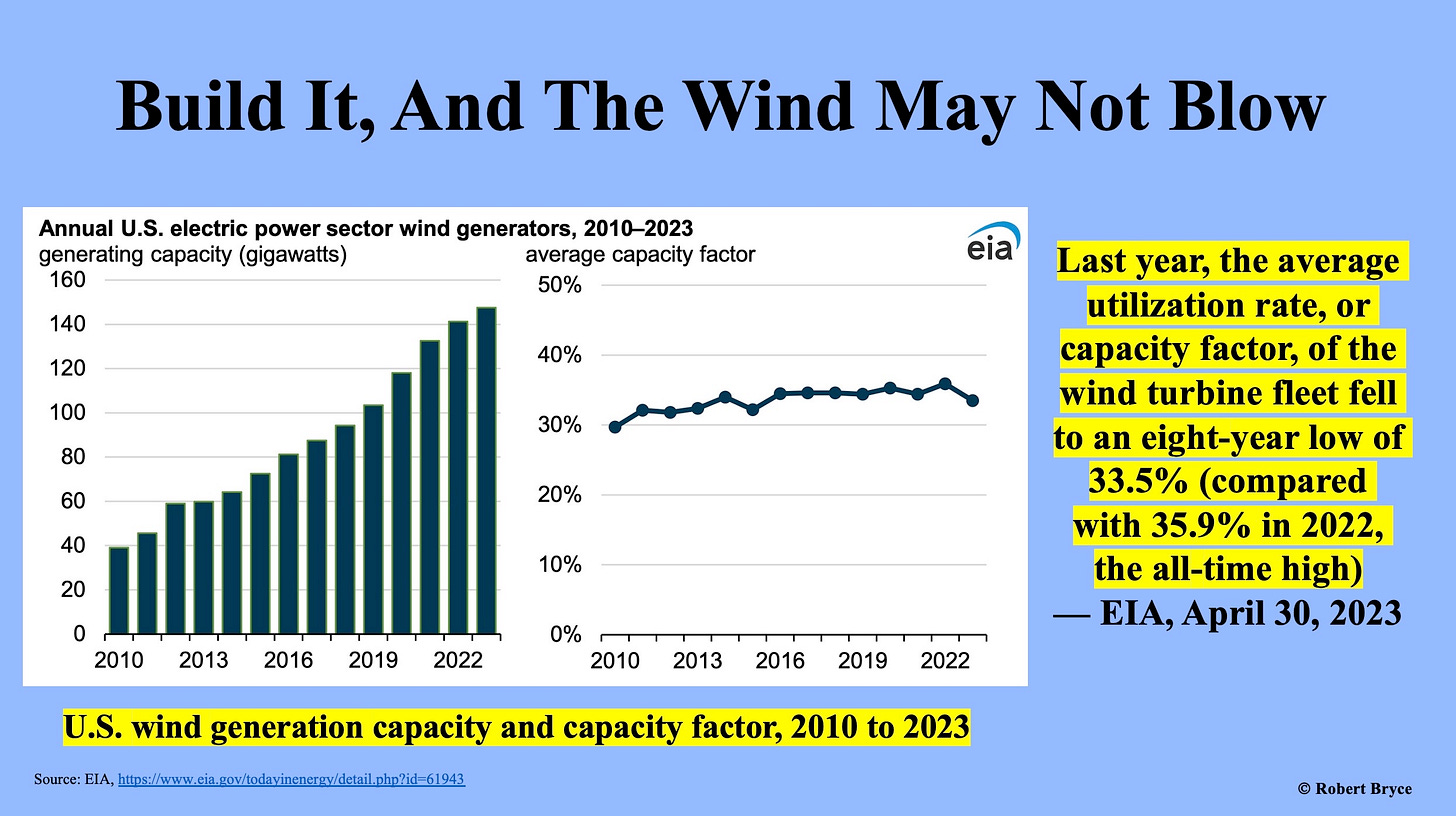Build It, And The Wind Won’t Come
Weather-dependent generation sources are...weather dependent: Last year, despite adding 6.2 GW of new capacity, U.S. wind production dropped by 2.1%.

Three years ago, in the wake of Winter Storm Uri, the alt-energy lobby and their many allies in the media made sure not to blame wind energy for the Texas blackouts. The American Clean Power Association (2021 revenue: $32.1 million) declared frozen wind turbines “did not cause the Texas power outages” because they were “not the primary cause of the blackouts. Most of the power that went offline was powered by gas or coal.”
NPR parroted that line, claiming, “Blaming wind and solar is a political move.” The Texas Tribune said it was wrong to blame alt-energy after Winter Storm Uri because “wind power was expected to make up only a fraction of what the state had planned for during the winter.” The outlet also quoted one academic who said that natural gas was “failing in the most spectacular fashion right now.” Texas Tribune went on to explain, “Only 7% of ERCOT’s forecasted winter capacity, or 6 gigawatts, was expected to come from various wind power sources across the state.”
In other words, there was no reason to expect the 33 GW of wind capacity that Texas had to deliver because, you know, no one expected wind energy to produce much power. Expectations? Mr. October? Playoff Jamal? Who needs them?
But what happens when you build massive amounts of wind energy capacity and it doesn’t deliver — not for a day or a week, but for six months, or even an entire year? That question is germane because, on Wednesday, the Energy Information Administration published a report showing that U.S. wind energy production declined by 2.1% last year. Even more shocking: that decline occurred even though the wind sector added 6.2 GW of new capacity!
A hat tip to fellow Substack writer Roger Pielke Jr., who pithily noted on Twitter yesterday, “Imagine if the U.S. built 6.2 GW new capacity in nuclear power plants and after starting them up, overall U.S. electricity generation went down. That'd be a problem, right?”
Um, yes. It would. And the EIA made that point in its usual dry language. “Generation from wind turbines decreased for the first time since the mid-1990s in 2023 despite the addition of 6.2 GW of new wind capacity last year,” the agency reported. The EIA also explained that the capacity factor for America’s wind energy fleet, also known as the average utilization rate, “fell to an eight-year low of 33.5%.” That compares to 35.9% capacity factor in 2022 which was the all-time high. The report continued, “Lower wind speeds than normal affected wind generation in 2023, especially during the first half of the year when wind generation dropped by 14% compared with the same period in 2022.”
Read that again. For half of last year, wind generation was down by a whopping 14% due to lower wind speeds. Imagine if that wind drought continued for an entire year. That’s certainly possible. Recall that last summer, the North American Electric Reliability Corporation warned that U.S. generation capacity “is increasingly characterized as one that is sensitive to extreme, widespread, and long duration temperatures as well as wind and solar droughts.”
According to Bloomberg New Energy Finance, corporate investment in wind energy between 2004 and 2022 totaled some $278 billion. In addition, according to data from the Treasury Department, the U.S. government spent more than $30 billion on the production tax credit over that same period. Thus, over the last two decades, the U.S. has spent more than $300 billion building 150 GW of wind capacity that has gobbled up massive amounts of land, garnered enormous (and bitter) opposition from rural Americans, and hasn’t gotten more efficient over time.
Wednesday’s EIA report is a stark reminder that all of that generation capacity is subject to the vagaries of the wind. Imagine if the U.S. had spent that same $300 billion on a weather-resilient form of generation, like, say, nuclear power. That’s relevant because Unit 4 at Plant Vogtle in Georgia came online on Monday. With that same $300 billion, the U.S. could have built 20, 30, or maybe even 40 GW of new nuclear reactors with a 92% capacity factor that wouldn’t rely on the whims of the wind. In addition, those dozens of reactors would have required a tiny fraction of the land now covered by thousands of viewshed-destroying, bat-and-bird-killing wind turbines.
If climate change means we will face more extreme weather in the years ahead — hotter, colder, and/or more severe temperatures for extended periods — it’s Total Bonkers CrazytownTM to make our electric grid dependent on the weather. But by lavishing staggering amounts of money on wind and solar energy, and in many cases, mandating wind and solar, that’s precisely what we are doing.
While chasing Moby Dick, Captain Ahab uttered a line that seems to fit the current moment: “Were I the wind, I'd blow no more on such a wicked, miserable world.”
Please click that ♡ button, share, and subscribe.






One element to look at, is that the installed capacity in the lower 48 of the wind generation fleet is aging fast. Wind units that were built 20 years ago are now really old. In dog years closer to 50 than 20 years. Their production whatever the capacity factor rating at the start just drops over time, the curve is ugly. The new secondary business for the big OEM's of wind turbines is "repowering" and it is just hitting its stride. So get ready for that evolution. When the wind production is being built the nacelles, hubs and blades go up with a 400 ton crane that took 52 diesel burning semi trailers to bring on site and days to assemble with diesel burning smaller cranes. If you have put these units up, say in the 1.5MW to 2.5MW size it dawns on you that what goes up, must stay up, the rigging alone on each unit during construction is a ballet. "Jesus don't drop it", comes to mind each time that 400 ton crane revs to higher RPM's lifting several tons of hub, or blades in a go. The nacelles on a 2.0 MW unit weigh 120 tones by the way. They are like a double wide trailer in the sky. Yeah, I know they don't look that big up there.....
So now all this capacity is 300 plus feet in the air, it has had the wind and weather kick the crap out of it, and the blades are showing signs of cracking and the site operators say we need to shut these units down and the owners, Private Equity guys with thin watches and chocolate brown suede soft sole Italian made loafers that cost a grand say "No way! Run them til they break, we have insurance or we will declare force majeure and walk away." (They learned this little trick at Harvard Business School, run it til it breaks is a 2 hour class)That is before we talk about the infrastructure like roads and electrical collection systems, substation and other maintenance requirements. The hydro guys have FERC up their backside EVERY year with dam safety inspections, 1 MW or 100 MW Regional Engineering staff sends out someone to clamber all over your project, and God help you if is there is a pebble out of place. Wind guys??? Good luck.
Lost in all of the wind grift is that a simple cycle or combined cycle natural gas fired turbine just blows way the wind (Pun intended and not) with their efficiency and capacity factor. What no one talks about with "Winter Storm Uri" is ERCOT's failure to have nominated enough forward natural gas to keep their jet engines going or even to get them to start up when the west Texas WTG's froze in place.
What we are all going to see and hear is US Senator Sheldon Whitehouse's (D. RI) caterwauling as the wind turbines off the coast of Newport Rhode Island start going up, as he sits in front of his private cabana at the Spouting Rock Beach Association (whites only please and you better bleed 14 generations of blue blood) and realizes HIS view scape is being hindered. The G5 hustling his ass back to DC to start hearings won't fly fast enough. In the meantime the PTC's and ITC's and bankers and construction firms,
and everything in between will just carry on. Nothing to see here folks, move along.
Pielke really nailed it in his post and highlights the issues of advertising a nameplate capacity for a device that will never even sniff it. If I told an industrial company that I would provide power at 35% of nameplate rating but also intermittently and unpredictably they would laugh me out of the building.
The battle on the horizon will be between the tech bros and the climate lobby. The amount of generation that will be needed for data centers and artificial intelligence is truly staggering and will require the buildout of much combined cycle natural gas generation. I think nuclear and small modular reactors will get there eventually but regulations will draw it out for at least a decade before they can be utilized. It will be interesting to see how it shakes out.